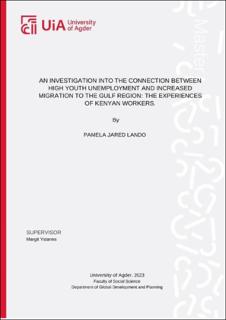| dc.description.abstract | . This study sought to investigate the connection between youth unemployment in Kenya and
increased migration to the Gulf region. Specifically, it examined the motivations for migration,
the role of economic independence and socio-economic aspirations in migration decisions, how
migrants seek information to help them decide whether to travel, and the lived experiences of
Kenyan migrant workers in the Gulf and how they respond to them. The study used the
qualitative research approach and semi-structured interviews to explore, frame, and analyse the
subject. Data were collected from 12 respondents using face-to-face and online interviews and
focus group discussions. The respondents were chosen through snowball sampling after
meeting the criteria for participation. The data was analysed using thematic analysis, where
multiple themes and subthemes emerged, including single motherhood stress, racism and
discrimination, shattered dreams, and media bias in framing migrant experiences in the Gulf.
Furthermore, the study established, against popular anti-Gulf narratives in the media, that the
experiences of migrant workers in the region were no different from those in other regions.
Most importantly, it determined that the motivation of Kenyan youth to migrate to the Gulf
region is driven by a complex set of factors, including poverty, social exclusion, the search for
better opportunities, and the desire to escape gender-based discrimination and domestic abuse.
While negative experiences such as racism, religious intolerance, overworking, sexual abuse,
and verbal abuse were reported, it was determined that they were no worse than in Kenya and
other regions. This finding is critical to dispelling harmful stereotypes and misconceptions
about migration to the Gulf. It revealed that the media often portrays a biased, inaccurate, and
incomplete picture of the migrant experience in the Gulf, which perpetuates harmful stereotypes
and misconceptions. The study recommends creating community programs, online support
groups, therapy, and counselling to help returnees, mostly single mothers, cope. Secondly, it
proposes active initiatives by the Kenyan government to make migration safer to ensure that
migrants are protected from abuse and exploitation. Thirdly, it advocates for policies to make
Kenya safer for women to live and raise their children. Lastly, it calls out the media to adopt a
more nuanced approach to reporting migrant experiences in the Gulf. The study overcame
limitations such as financial constraints, limited time, gatekeepers who were unwilling to assist,
and the stigmatisation of rape and other sexual offences that made some participants reluctant
to share their experiences, to deliver a document that could impact policy and save lives. | |
